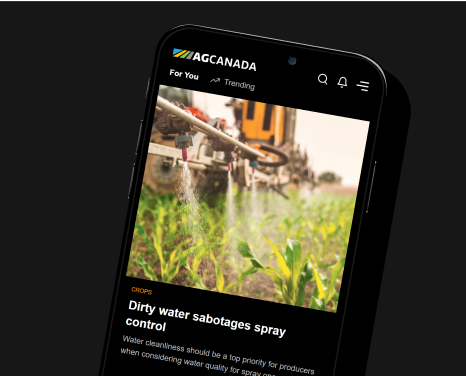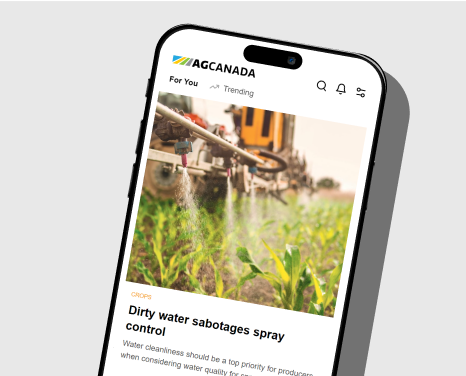The blockchain basics
| 8 min read

A Manitoba startup says blockchain is the future of the food supply chain. Photo: Getty Images
Winnipeg tech startup TheoryMesh is using blockchain technology to help agri-food companies share information and build transparency.
The word “blockchain” may more readily conjure the image of cryptocurrency than of oats and pulses, but experts say blockchain’s future in food transparency and other ag application is pretty much a given.
“I think we’re going to see some form of blockchain or digital ledger underpin food systems in the future,” said Chris Bunio, co-founder and CEO of TheoryMesh.
What is blockchain?
Avena Foods Limited is a specialty miller of gluten-free pulses and oat ingredients with sites in Regina and Rowatt, Saskatchewan and Portage la Prairie, Manitoba. It’s one of TheoryMesh’s first clients.
The company touts its oats as “uncontaminated for people with celiac disease and gluten sensitivity,” and pulses as “sustainably grown and milled.”
From the farm until the products leave Avena’s facilities, they’re creating and surrounded by data. However, a lot of that information is in isolated spreadsheets or on paper, said Bunio.
TheoryMesh will begin by digitizing everything so it can be shared throughout the company via blockchain.
“Blockchain is a mechanism for creating a distributed ledger,” wrote Wesley Crook in a February 2020 Forbes magazine article. “Distributed in this sense means that multiple parties can participate, view and audit the data contained within this ledger.”
Experts the Co-operator spoke to generally fell back on analogy to explain this digital tool.
It’s a bit like “a shared Excel spreadsheet, which all players inside the value chain have access to,” said Jamie Denbow, director of business development at ag-tech firm Farmers’ Edge.
Each member has its own tab on the metaphorical spreadsheet and can input data.
Unlike a spreadsheet, the data in each cell can’t be altered. Once entered, it becomes part of the blockchain, visible to all members.
This provides assurance to the chain’s members that “what the data is, is what the data is,” Denbow said.
It can also prevent data leaks, he added. A spreadsheet can be downloaded and shared. Members of a blockchain can view it and enter their data through a shared portal but can’t export the data.
For now, Avena’s blockchain will begin when they receive grain from the producer.
“We are capturing the details on their contracts and their receipt of goods,” said Bunio. “There is some information coming from the farm and it will be extended over time.”
But if a processor desired, it could start its blockchain even earlier.
In 2019, the Canadian Seed Growers Association (CSGA) ran a pilot program alongside tech firm Grain Discovery to use blockchain to trace soybean seed variety OAC Kent from development, seed certification, to the farm, the elevator, until it reached Ying Ying Soy Food Ltd., in Toronto, which made the soybeans into tofu.
The pilot worked, the tech worked, said Doug Miller, CSGA’s executive director and CEO. However, like Avena, CSGA was still dealing with records that didn’t play nice with the new tech.
“We still had paper certificates at the end of our processes that didn’t really work in a digital world,” Miller said.
CSGA recently finished digitizing its records and processes and has developed infrastructure so its members can connect to blockchain when that opportunity arises.
“You let us know, and then we connect our infrastructure to it,” he said. “The seed growers don’t have to go out and develop their own blockchains or host their own nodes.”
At the other end, blockchain could stretch all the way up to the consumer, who — as more than one expert noted — could use a QR code on the packaging to access information about where the food came from and how it was produced.
Why blockchain?
Avena Foods didn’t respond to the Co-operator’s requests for an interview. However, a Sept. 10 joint news release with TheoryMesh said it will use blockchain technology to “digitize food safety and traceability processes.”
“Their solutions… will streamline our data handling,” said Sneha Nathani, VP of Food Safety and Quality Assurance at Avena. “The TheoryMesh solution will reduce time in every step of our processes and will significantly improve our systems.”
The basic application is increased efficiency and security in sharing information, which is increasingly important as consumers demand greater transparency.
One benefit may be what Miller called “social licence,” which is the public acceptance of a company or producers’ practices.
“Farmers are increasingly under like kind of a microscope, but the thing is at the end of the day we do really good stuff here in Canada,” Miller said. “This represents an opportunity for Canadian producers to be able to tell our story in a curated way that kind of resonates with consumers.”
Secondly, said Miller, blockchain can be used to increase efficiency and mitigate risk at the processor level. Rather than checking tags and paper documentation to prove, for instance, the processor received the precise type of soybean it needed, the info can arrive digitally.
Data in the blockchain could also be used to quickly track down affected products in case of a recall. In 2018, after an E. coli outbreak in romaine lettuce made more than 200 people in the U.S. sick, Walmart told suppliers they’d have to use its blockchain platform to trace their products, NBC reported.
Walmart said this would allow suppliers to trace products by production lot in seconds rather than days.
“Blockchain is developing right now in agriculture,” said Denbow. “Blockchain will become prevalent in agriculture. And why am I confident in saying this? Well, all major banks are using blockchain right now. If you look at all the major health-care chains in the U.S., they’re all using blockchain. And why? Because it’s proven effective.”
Denbow said the market may divide into two streams — ordinary food products, and food products containing traits, e.g. GMO free, organic and sustainability claims backed up by data.
On the farm
Avena’s blockchain doesn’t yet extend to the farm, but Bunio indicated it will. TheoryMesh has mobile and web apps to capture data, and is working on systems to automatically bring in Excel documents and handwritten forms.
Generally, farm-level data and proof of practice is becoming more in demand. For instance, General Mills contracts glyphosate-free grains. Companies like Nutrien have recently rolled out pilots to pay farmers for storing or reducing carbon through farming practices like no till and nitrogen management.
In the future, producers may be able to share data, via blockchain, from their equipment and farm-management software to show when and where it applied chemicals.
It could also validate a farmers’ claim he or she didn’t till.
“Here’s the GIS (Geographic Information System) data that says nothing was done on this field,” Bunio said.
“I feel that blockchain is actually going to bring value into our supply chain, allowing growers to actually be able to take advantage of higher-value opportunities,” said Denbow.
Farmers may, however, be tempted to throw up their hands. Digital paperwork is still paperwork. It also may be more accountability than they want.
“I never saw a benefit for farmers… unless of course they’re compensated or they’re rewarded (for participating),” said Sylvain Charlebois, director of the Agri-Food Analytics Lab at Dalhousie University.
A company might say blockchain participation is about love, trust and co-operation, he said, but that doesn’t put more money in farmers’ pockets. They should ask, “What’s in it for us?” Charlebois added.
Security
Farmers should also be concerned about data safety, said Bunio.
“The basic questions every farmer should feel comfortable with asking are: What is the purpose of data capture?; How is the data being used?; and, How will it provide them with a benefit?” he said.
Denbow added that not all data known to each “link” of the chain is shared with the rest of the chain. “Only the data that is critical to the final product is shared forward through the chain.”
Farms also need to have the bandwidth and technology to connect and share data. The percentage of growers with full digital connectivity and data collection on their farm now is maybe 15 per cent, said Denbow.
“Right there, that’s the first step. You need that fully digitized, accessible dataset so that you can share it with members of the chain,” he said.
“What’s going to be holding us back is broadband access or 5G… that ability to connect, to upload that data is going to be key,” said Keith Currie, vice-president of the Canadian Federation of Agriculture (CFA).
Rural connectivity is getting better and better, Currie said, but we need to continue to push governments to expand it.
Finally, policy needs to protect farmers, Currie said. Big companies may eventually pressure producers to share their data, he said. Policy should ensure blockchain is brought in and administered in a way that’s fair for all.
“At the end of the day the farmers always lose in these battles, so how it’s implemented is important,” Currie said.
This article appeared in the Oct. 21, 2021 issue of the Manitoba Co-operator.


